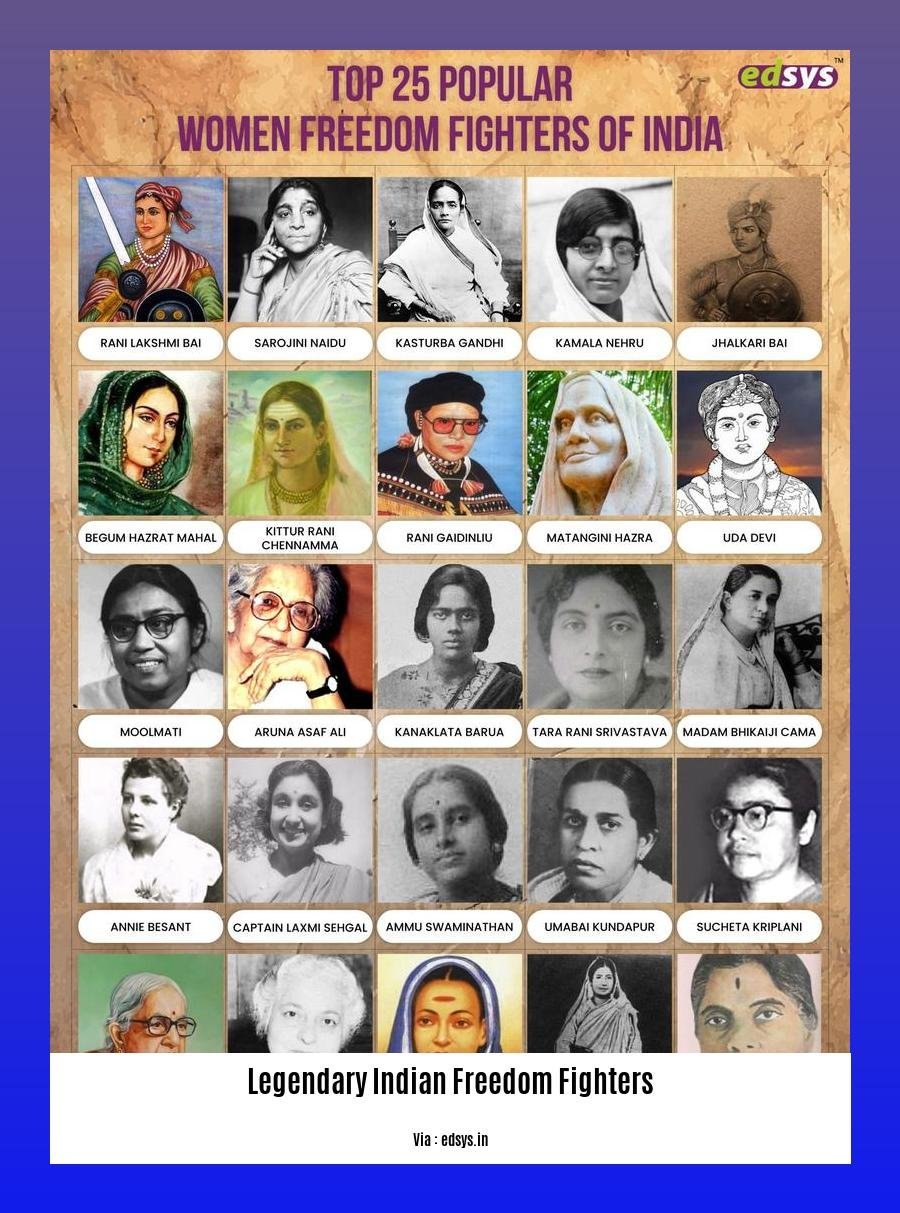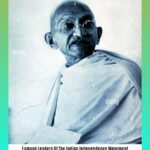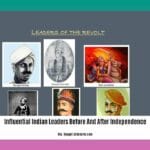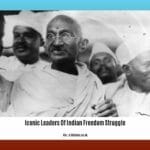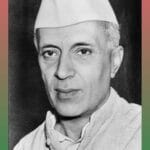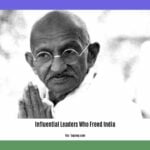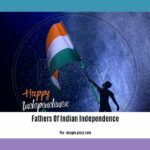Step into a saga of valor and sacrifice as we delve into the chronicles of Legendary Indian Freedom Fighters: Their Indomitable Spirit of Liberation. These extraordinary individuals, driven by an unyielding patriotism, played pivotal roles in shaping the destiny of India. Their stories, etched in the annals of history, serve as a beacon of inspiration, reminding us of the extraordinary lengths one can go to for the freedom of their nation.
Key Takeaways:
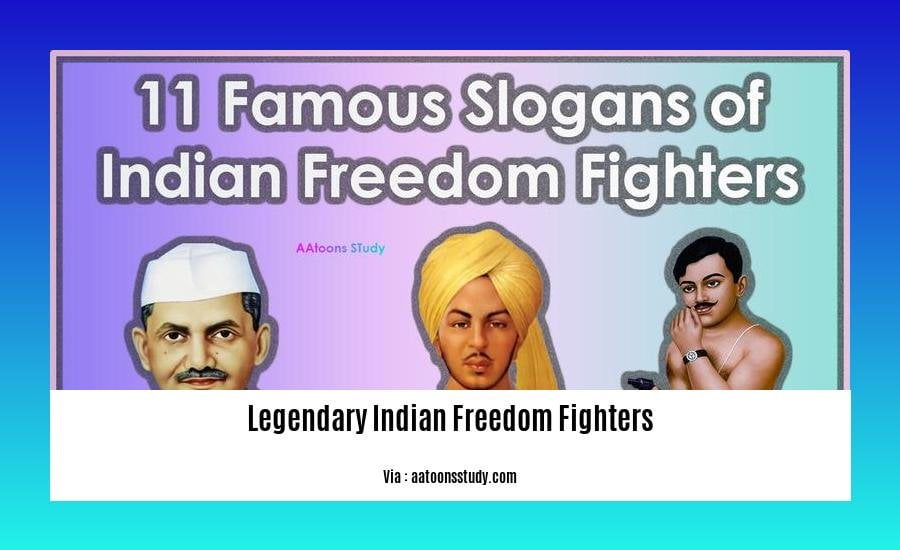
- Indian freedom fighters bravely led the nation towards independence.
- Well-known freedom fighters include Mahatma Gandhi, Jawaharlal Nehru, Chandra Shekhar Azad, and Rani Lakshmi Bai.
- Freedom fighters were recognized by the government after independence and received benefits such as pensions.
- They faced imprisonment, exile, and torture for their unwavering determination to liberate India.
- A comprehensive list of freedom fighters is available on Wikipedia.
Legendary Indian Freedom Fighters
The Unsung Heroes of India’s Independence
India’s struggle for independence from British colonial rule was a saga of courage, sacrifice, and unwavering determination. At the forefront of this struggle were legendary freedom fighters who ignited the spirit of liberation in the hearts of their countrymen. These heroes came from diverse backgrounds and employed various strategies, but they were united by a common dream—a free and self-governed India.
Mahatma Gandhi: The Beacon of Nonviolence
Mahatma Gandhi, the towering figure of India’s independence movement, epitomized the power of nonviolent resistance. His philosophy of Satyagraha, rooted in truth and non-violence, inspired millions to join the fight for freedom. Gandhi’s unwavering belief in peaceful protest and his ability to mobilize mass support played a pivotal role in India’s eventual independence.
Jawaharlal Nehru: The Visionary Architect
Jawaharlal Nehru, a close associate of Gandhi, was another key architect of India’s independence. As the first Prime Minister of independent India, he played a crucial role in shaping the nation’s political and social landscape. Nehru’s commitment to socialism, secularism, and democratic values laid the foundation for a modern and progressive India.
Subhas Chandra Bose: The Advocate of Armed Resistance
Subhas Chandra Bose, a charismatic leader of the Indian National Army, believed in armed resistance to British rule. He organized the Indian National Army, consisting of Indian soldiers from prisoners of war, and fought alongside the Japanese against the British in World War II. Bose’s call for an “armed rebellion” resonated with many Indians who were impatient with the pace of Gandhi’s nonviolent movement.
Bhagat Singh: The Revolutionary Icon
Bhagat Singh, a young revolutionary socialist, became a symbol of resistance and patriotism. He carried out daring raids and assassinations against British officials, capturing the imagination of Indians across the country. Singh’s ideology and ultimate sacrifice continue to inspire generations of Indians.
Sardar Vallabhbhai Patel: The Unifier of India
Sardar Vallabhbhai Patel, known as the “Iron Man of India,” played a key role in integrating over 500 princely states into the Indian Union after independence. His administrative skills and strong leadership were instrumental in establishing a unified and stable India.
The Spirit of Liberation
The legendary Indian freedom fighters were not just individuals; they were symbols of a collective aspiration for freedom. Their sacrifices, unwavering determination, and infectious spirit of liberation ignited the flame of independence in the hearts of millions of Indians. Their legacy continues to inspire and guide us today, reminding us of the power of human courage and the indomitable spirit that can overcome any obstacle.
Are you curious to learn more about the famous leaders of the Indian independence movement? They played a pivotal role in shaping the destiny of India. To understand the true heroes who dedicated their lives to the fight for freedom, read all about the fathers of Indian independence. If you wish to dive deeper into the stories of these extraordinary individuals, explore the profiles of influential leaders who freed India.
Subhas Chandra Bose and Armed Resistance
Subhas Chandra Bose, the charismatic leader known as “Netaji,” played a pivotal role in India’s fight for freedom. Unlike Mahatma Gandhi’s nonviolent approach, Bose believed in armed resistance against the British rule.
In 1943, Bose formed the Indian National Army (INA), comprising Indian soldiers who had been prisoners of war. The INA fought alongside the Japanese against the British in Southeast Asia, raising hopes for India’s liberation.
Bose’s leadership and the INA’s actions ignited a fire among Indians, inspiring them to fight for their independence. Though the INA was ultimately defeated, its legacy continues to inspire generations of Indians.
Key Takeaways:
- Subhas Chandra Bose advocated for armed resistance against British rule.
- He formed the Indian National Army (INA) to fight alongside the Japanese.
- The INA’s actions inspired Indians to fight for their freedom.
- Bose’s legacy remains a symbol of India’s struggle for independence.
Most Relevant URL Source:
Bhagat Singh and Revolutionary Socialism
The Indian freedom struggle witnessed the rise of Bhagat Singh, a prominent revolutionary who espoused the ideology of revolutionary socialism. His unwavering belief in violent resistance against British rule and his radical socialist views set him apart from other freedom fighters.
Singh’s Revolutionary Ideology
Influenced by socialist thinkers like Karl Marx and Vladimir Lenin, Singh believed that capitalism and imperialism were inherently oppressive systems. He advocated for a socialist revolution that would overthrow the British colonial government and establish a classless society.
Violent Resistance
Unlike Gandhi’s nonviolent approach, Singh saw armed resistance as the only way to achieve independence. He participated in daring raids on government buildings and assassinations of British officials, becoming a symbol of defiance against the colonial power.
Legacy of Bhagat Singh
Bhagat Singh’s execution by the British in 1931 at the age of 23 made him a martyr and an icon of the freedom movement. His revolutionary ideas and sacrifice inspired generations of freedom fighters and activists, both in India and beyond.
Key Takeaways:
- Bhagat Singh was a prominent Indian revolutionary who advocated for revolutionary socialism.
- He believed capitalism and imperialism were inherently oppressive systems.
- Singh used violent resistance to challenge British rule and inspire mass support.
- His execution made him a martyr and an icon of the Indian freedom movement.
- Singh’s socialist ideology remains relevant in contemporary discussions on social justice and economic equality.
Most Relevant URL Source:
- Bhagat Singh: The Revolutionary Martyr who Fought for India’s Freedom
Sardar Vallabhbhai Patel and Indian Unity
It would be impossible to overstate the pivotal role Sardar Vallabhbhai Patel played in forging a unified, independent India. As the country’s first Deputy Prime Minister and Home Minister, Patel skillfully negotiated the integration of over 500 princely states into the Indian Union, a task of monumental complexity.
His unwavering determination and political acumen earned him the title “Iron Man of India.” Patel’s legacy as a champion of national unity continues to inspire Indians today.
Key Takeaways:
- Patel’s efforts solidified India as a coherent and cohesive nation.
- As Home Minister, Patel ensured internal security and stability.
- His political legacy emphasizes the importance of unity and national integration.
Most Relevant URL Source:
- Vallabhbhai Patel: The Iron Man of India
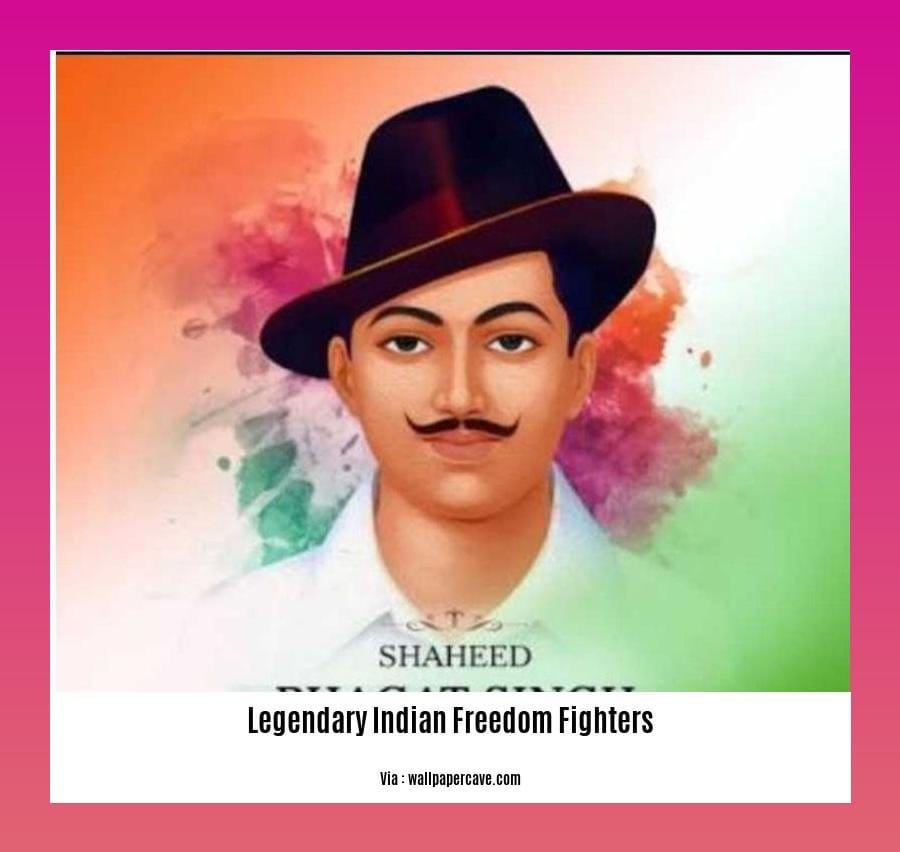
FAQ
Q1: Who were the most prominent freedom fighters in the Indian independence movement?
Q2: What were the key strategies and tactics employed by Indian freedom fighters?
Q3: What challenges and hardships did Indian freedom fighters face during their struggle for independence?
Q4: How did the sacrifices of freedom fighters inspire the Indian people?
Q5: What is the legacy of Indian freedom fighters in modern-day India?
- Guatemala vs. Costa Rica: Plan Your Trip Smartly - April 16, 2025
- Master Types of Pumps: Ultimate Guide to Selection - April 16, 2025
- Unlock Types of Makeup Secrets: Master Any Look Now - April 16, 2025
